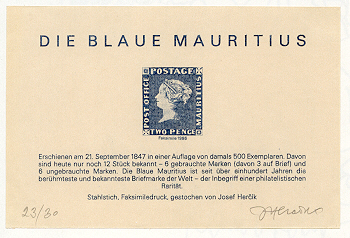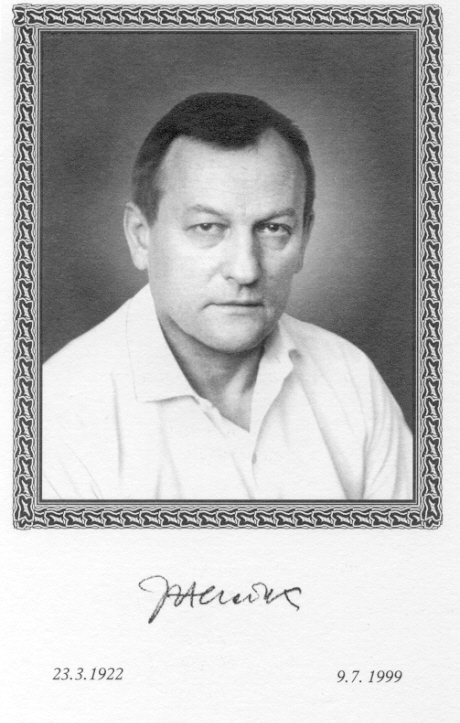|
|
|
|
|
|
On Friday, July 9th, just several months
after celebrating his 77th birthday, Josef Hercík died in Prague. One of
the most outstanding Czech graphic artists and engravers, he was the
engraver and/or designer of more than four hundred Czech, Czechoslovak,
and foreign postage stamps, as well as prints, postal cancels, stocks and
so on.
The name Hercík is synonymous with the
value and individuality of perhaps the smallest and youngest applied art
of our time. The personal contribution of Josef Hercík who, along with
Bedrich Housa, was the Nestor of contemporary, top-quality Czech stamp
engraving.
Engraver Josef Hercík began his engraving activity by decorating guns at
the arms factory in Uherský Brod. Step by step he worked his way up to
becoming a phenomenon of Czechoslovak and, subsequently, Czech stamp
creativity. In pursing the engraving profession, he was assisted by his
demanding and reliable preparation, often bordering on pedantic tenacity.
Superlative preparation of stamp engravings is attested to by his
execution of, for example, Picasso’s “Guernica” or
Titian’s (Tiziano Vecelli) “Apollo punishing Marsyas,”
which exemplifies the absolute top of the engraver’s art. Certainly
the awards he has received, starting in 1967, attest to the recognition of
his talent: five time the 1st prize of the Ministry of Communications of
CSSR for engraving transposition; Grand Prix in Naples for
“Guernica; III prize in Milan for Preisler’s “Black Lake
(1968);” and the most beautiful stamps issued to mark EXPO in Osaka
— “View of Fujiyama” and Orlik Castle (1970). Together
with Vladimír Kovárík, in 1971 he received the award for the most
beautiful stamp with a sports theme. (Coincidentally they both died in the
same year and the same month, just three days apart). Josef Hercík
received many awards, not only those enumerated. He also received
politically tinged awards — Honored Artist of the CSSR (together
with Jirí Svengsbír) and For Merit in Construction; in his case it was
for persistent hard work with an engraving tool in hand, continual eye
stress, thousands of “peaceful” hours of sitting at tiring
miniatures engraved into the hardest metal — steel.

Great recognition of Hercík’s
engraving was also indicated by the order from the German publisher
Hermann Sieger Verlag to prepare facsimiles of the most beloved stamp
classics, including the renowned Blue Mauritius. We recall that Hercík
was constantly in the caldron of foreign postal authorities’
interest, offering active participation in the stamp production plans of
post offices throughout the world. At random we can cite Monaco and the
United Nations Organization (UNPA), though there are many others for whom
he produced. He himself said “I have long since inscribed stamp
creation on my soul, but first of all I wish to create Czechoslovak stamps.
Here I know precisely for whom I am creating, I know they think just as I
do; I am here where the essence not only joins the contemporary, but also
is the legacy of the great, world renown graphic artist Václav Hollar.
Josef Hercík made his stamp debut in
1962 when he engraved stamps in the insect series designed by Sivko. (Václav
Sivko actually “discovered” Hercík for stamp creation).
Paradoxically, these stamps was issued later than his next stamp in the
series marking the World Exhibition of Postage Stamps, PRAGA 1962. From
that time on he engraved or designed and engraved more than 400 postage
stamps, not counting the hundreds of drawings for first day cover cachets
and postal cancellations. Hercík never limited himself to only the mere
engraving requirements. His transcription retains all the details of the
original, but adds the engraver’s creative inventiveness. It depends
on his ability whether multicolored drawings will be translated by
imperceptible transitional lines into engraved stamp image, produced with
a maximum of the five basic colors. Furthermore, the engraving works only
in a linear net, in contrast to a flat effects of a brush.
It was simpler on those stamps where Hercík
himself created the design or at least was able to select the subject.
Over the years Hercík was well disposed toward philatelic exhibitions.
Here he met with his admirers and he was able to sign autographs for hours
on end to satisfy the long, snaking line of Czech collectors. Already in
Josef Hercík’s artistic development we are able to observe his
inclination toward the creation of postage stamps. This, however, does not
mean that Josef Hercík was focused artistically on a narrow
specialization. At the beginning and throughout, Hercík devoted himself
in parallel to graphic design: fine, heraldic, floral, Prague themes...
Motivation is found, first and foremost,
in the hundred and one views of the Mother of Cities — Prague. His
Prague is comparable to and yet different from the Prague of Jirí
Svengsbir. Where Svengsbir piled up dominants, infusing them with fanciful
suns, Josef Hercík treated his observations more realistically. Even
though his Pragues are static gothic lines here and there broken by the
curves of baroque and renaissance structures, warmth emanates from gentle
dashes of the outline and masterful control of light and shadow, together
creating the feeling of gradual linking to the third dimension. The
domiciliary meaning of his excellently executed calligraphy, which draws
on his beloved heraldic themes, make Josef Hercík’s Prague series
much sought after prints. All the more so in that they are a statement of
a highly cultured man who has completely mastered the intimate knowledge
of steel. These are the professional demonstrations of the authors
inventiveness in one of the most difficult graphic disciplines —
steel engraving.
Josef Hercík was, during all his 77
years, always an active graphic artist full of vitality. During his last
years, along with his wife Helen, who was during all those years his
consort and closest printer, and with their son, Josef, and daughter-in-law,
founded the First Czech Graphic Society which quickly gained enormous (and
State) respect and garnered orders throughout the world. It became one of
the four licenced Czech security printers concentrating on production of
Graphic artists’ commercial and security papers as well as stocks.
Josef anticipated long ago that his son Josef would continue his engraving,
graphic, and printing activities and thus give continuity to the Hercík
name. How many fathers succeed in accomplishing that which the late Josef
Hercík accomplished? Unselfish and self-sacrificing, Hercík schooled a
number of beginning engravers who today successfully continue the so-called
Czech school of stamp engraving.
The entire world, especially Japan,
envied our strong plethora of Czech and Slovak stamp engravers. For the
entire time since his debut, Josef Hercík was at the very pinnacle of
this plethora. The master’s engraving tools of Josef Hercík senior
have been symbolically orphaned.
We thank you, Master Hercík!
|
![]()



